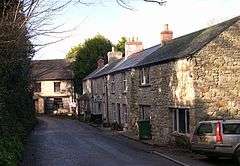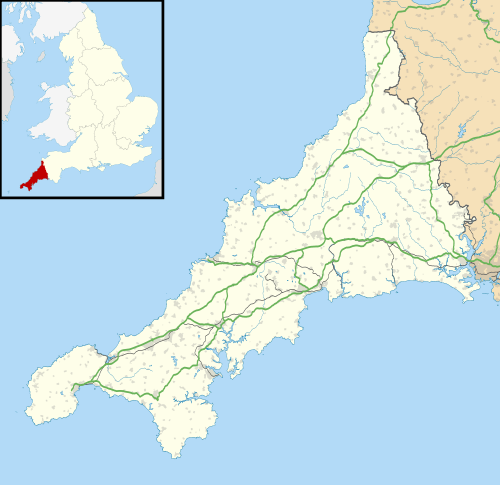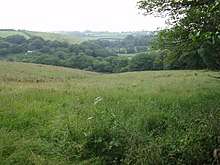St Hilary, Cornwall
St Hilary is a civil parish and village in west Cornwall, England, United Kingdom. It is situated approximately five miles (8 km) east of Penzance and four miles (6.5 km) south of Hayle.[1]
| St Hilary | |
|---|---|
 Cottages near St Hilary Church | |
 St Hilary Location within Cornwall | |
| Population | 821 (2011 census) |
| OS grid reference | SW550312 |
| Unitary authority | |
| Ceremonial county | |
| Region | |
| Country | England |
| Sovereign state | United Kingdom |
| Post town | PENZANCE |
| Postcode district | TR20 |
| Dialling code | 01736 |
| Police | Devon and Cornwall |
| Fire | Cornwall |
| Ambulance | South Western |
| UK Parliament | |
Chynoweth is an area immediately north of St Hilary churchtown. The land of the parish is high enough to provide views of bays on both coasts, St Ives Bay five miles north and Mount's Bay two miles south.[2]
For the purposes of local government St Hilary has a parish council and elects councillors every four years. The principal local authority in the area is Cornwall Council. During the height of mining activity the population was three times that in the 1930s.[3]
Geology
The area has many former mines: especially notable was a mine called Wheal Fortune which extended into the parish of Ludgvan. Penberthy Croft Mine, to the north of the parish, was designated a Site of Special Scientific Interest in 1993 and is noted as the most important site in Britain for secondary ore minerals of lead, copper, and arsenic.[4] Wheal Jewell, a mine between Marazion and Goldsithney, put its 40-inch cylinder pumping-engine up for auction on 21 July 1884, alongwith other plant and tools.[5]
An earthquake occurred in St Hilary in 1796.[6]
Notable buildings
The parish church is dedicated to Saint Hilary of Poitiers and is in the Early English style but had to be rebuilt after a fire in 1853. It has a 13th-century tower and is a Grade I listed building.[7] Ennys Manor farm on Trewhella Lane dates from 1688, and was the home of the Millet family until the 19th century and then passed by marriage to the Grylls family.
A children's home existed in St Hilary in the 1920s and 1930s, accommodated in a former pub, the Jolly Tinners.[8]
Notable residents

Notable people from the parish include three former Vicars, the writer Denys Val Baker, and the artist Anne (Annie) Walke (wife of Bernard Walke).[9]
Malachy Hitchins[10] was an astronomer and Vicar of St Hilary. Thomas Pascoe was Vicar of St Hilary for 56 years in the 19th century.[2] Bernard Walke was Vicar of St Hilary, from 1913 to 1936.[11] Father Walke was the author of four religious plays and of an autobiography, Twenty Years at St Hilary (London: Methuen & Co., 1935; reissued by Mott, London, 1982 with an introduction by Frank Baker and ISBN 0-907746-04-7).
The youngest son of Malachy Hitchins, Fortescue Hitchins (1784–1814), was born at St Hilary. He became a solicitor at St Ives, Cornwall, and was the author of "The Tears of Cornubia" and other poems. He compiled material for a history of Cornwall, which after his death was edited by Samuel Drew, and published in 1824.
Legend
The ghost of Rev. John Penneck, Chancellor of Exeter, (died 1724) is said to raise great storms here.[12]
References
- Ordnance Survey: Landranger map sheet 203 Land's End ISBN 978-0-319-23148-7
- Mee, Arthur (1937) Cornwall. (The King's England.) London: Hodder & Stoughton; p. 221
- Walke, B. (2002) Twenty Years at St Hilary. Mount Hawke: Truran; p. 190
- "Penberthy Croft Mine" (PDF). Natural England. 1993. Retrieved 8 November 2011.
- "Mining machinery, Plant, and Materials". The Cornishman (313). 17 July 1884. p. 1.
- Archived April 6, 2007, at the Wayback Machine
- "St Hilary". GENUKI. 25 March 2012. Retrieved 5 October 2012.
- Walke, B. (2002) Twenty Years at St Hilary. Mount Hawke: Truran; pp. 190-97
- "Anne Walke". Penlee House, Penzance. Retrieved 9 September 2012.
- Malachy Hitchins Oxford Dictionary of National Biography index
- Brown, H. Miles (1976). A Century for Cornwall. Truro: Blackford, pp. 64, 75, 92, 98-100
- Anthony D. Hippisley Coxe, Haunted Britain, pg. 22, McGraw-Hill Book Company, New York 1973
Further reading
- Pascoe, Charlotte Champion (1879) Walks about St. Hilary: chiefly among the poor. Penzance: Beare
External links
| Wikimedia Commons has media related to St Hilary, Cornwall. |
- "Online Catalogue for St Hilary". Cornwall Record Office.